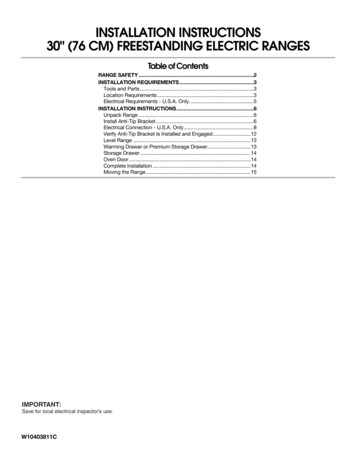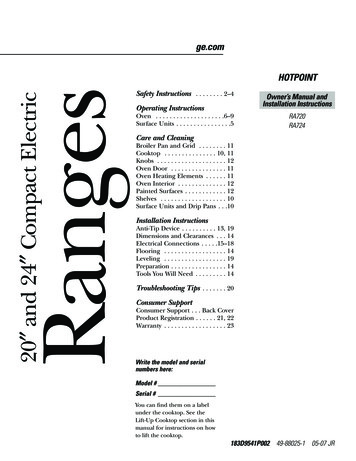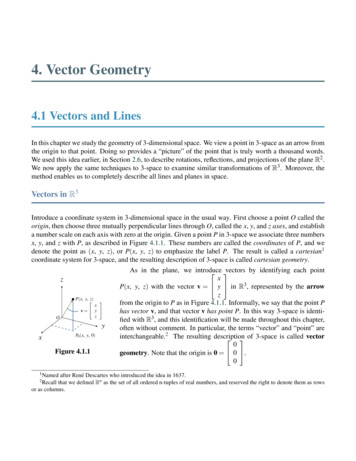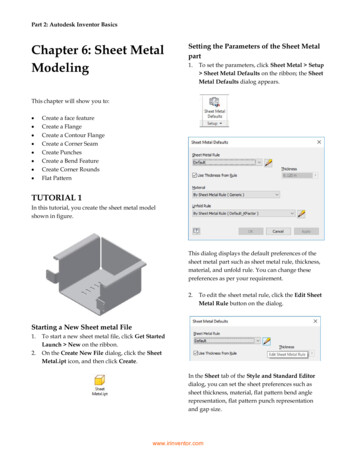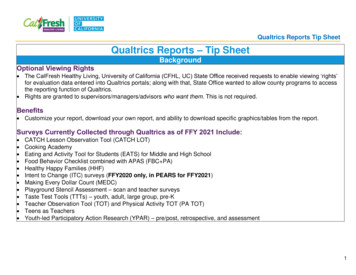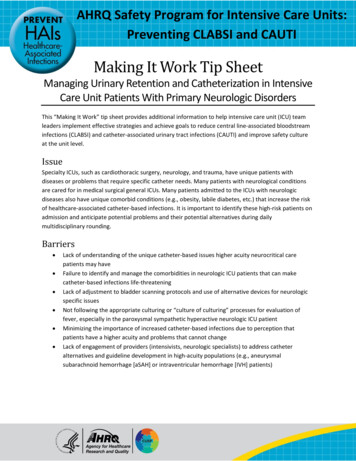
Transcription
AHRQ Safety Program for Intensive Care Units:Preventing CLABSI and CAUTIMaking It Work Tip SheetManaging Urinary Retention and Catheterization in IntensiveCare Unit Patients With Primary Neurologic DisordersThis “Making It Work” tip sheet provides additional information to help intensive care unit (ICU) teamleaders implement effective strategies and achieve goals to reduce central line-associated bloodstreaminfections (CLABSI) and catheter-associated urinary tract infections (CAUTI) and improve safety cultureat the unit level.IssueSpecialty ICUs, such as cardiothoracic surgery, neurology, and trauma, have unique patients withdiseases or problems that require specific catheter needs. Many patients with neurological conditionsare cared for in medical surgical general ICUs. Many patients admitted to the ICUs with neurologicdiseases also have unique comorbid conditions (e.g., obesity, labile diabetes, etc.) that increase the riskof healthcare-associated catheter-based infections. It is important to identify these high-risk patients onadmission and anticipate potential problems and their potential alternatives during dailymultidisciplinary rounding.Barriers Lack of understanding of the unique catheter-based issues higher acuity neurocritical carepatients may haveFailure to identify and manage the comorbidities in neurologic ICU patients that can makecatheter-based infections life-threateningLack of adjustment to bladder scanning protocols and use of alternative devices for neurologicspecific issuesNot following the appropriate culturing or “culture of culturing” processes for evaluation offever, especially in the paroxysmal sympathetic hyperactive neurologic ICU patientMinimizing the importance of increased catheter-based infections due to perception thatpatients have a higher acuity and problems that cannot changeLack of engagement of providers (intensivists, neurologic specialists) to address catheteralternatives and guideline development in high-acuity populations (e.g., aneurysmalsubarachnoid hemorrhage [aSAH] or intraventricular hemorrhage [IVH] patients)
Suggested Strategies Establish an environment that encourages the staff to become empowered and engaged toaddress the unique problems that higher acuity neurologic ICU patients may have with catheterutilization and infection prevention.Realize that although every ICU may have patients that are higher acuity than typical, it ispossible to address patient-specific problems that any ICU can manage.Utilize daily multidisciplinary rounding and catheter assessment discussions for catheterremoval and the use of alternatives.Consider catheter replacement protocols for changing any catheter that was placed emergentlywithout strict sterilization techniques. Routine catheter exchanges should not be performed.On admission and during multiprofessional rounds, identify and address specific issues thatplace aSAH, spinal cord injured, or other neurologic patients at higher risk for prolongedcatheter use.Assess potential daily use of clean intermittent catheterization as an alternative for neurologicICU patients, especially in patients with a neurogenic bladder.To meet the need for complex neurologic ICU patients, consider shortening the intervalbetween bladder scanning and intermittent urinary catheter assessments every six hours toevery four hours.Consider the use of silver or antibiotic-coated urinary catheters only for unique patientsituations that may require long-term catheter use.Consider earlier timing of urinary diversion techniques for managing potential prolongedneurogenic bladder dysfunction conditions in select patients.Utilize the “culture of culturing” processes for fever evaluation in neurological ICU patientsespecially in paroxysmal sympathetic hyperactivity patients.Utilize real-time, multiprofessional, and multipronged approaches to identify patient specificmanagement on high-acuity, high-risk patients in order to decrease catheter utilization (e.g.,rapid response catheter assessment team – members of comprehensive unit-based safetyprogram [CUSP] team, ICU-trained RNs, physician champions, etc.).Engage neurology and neurologic surgery providers in developing protocols for their uniqueneurologic ICU patient populations that are challenged with frequent CAUTIs.Conversation StartersUse Situation-Background-Assessment-Recommendation (SBAR) to bring awareness to the ICU team. Asample script is provided below.Situation: Team, over the last 6 months, we have seen a significant increase in our indwelling urinarycatheter utilization and CAUTI rates.Background: We have new neurosurgeons employed by our institution and have had several challengingcases of aSAH patients. The concern is that our education practices for onboarding new providers as wellAHRQ Safety Program for ICUs: Preventing CLABSI and CAUTINeuro Patients2
as education around urinary catheter alternatives and appropriate culturing processes need to behardwired into practice.Assessment: Based on the root-cause analysis, we determined that catheter alternatives and the aSAHspecific nurse-driven protocols were not being utilized. These protocols included adjusting intermittentcatheter use on aSAH patients to meet catheter utilization reduction and reducing catheter-basedinfections. We also determined that the neurosurgical group and the intensivists were not consistentlyprovided access to individual catheter utilization and infection data on a real-time basis.Recommendation: If we could reduce catheter utilization and engage the neurosurgeons in the process,we may improve outcomes and prevent several CAUTIs this year. What are your thoughts on prioritizingthe work with the CUSP team, chief medical officer, and nursing champions in the unit to update anurse-driven protocol that identified criteria to remove the urinary catheters in specific neurologicconditions?Other recommendations include: Develop a neurologic condition–specific bladder scanner protocol with engagement of theneurosurgical group that requires an every-four-hour scan can on complex neuro ICU patientswith the potential for neurogenic bladder dysfunction, which could prevent overdistension ofthe detrusor bladder musculature and worsen neurogenic dysfunction.Present CAUTI and catheter utilization rates to individual providers and add as part of theirannual quality metrics.Discuss the defects analysis and CAUTI data with senior leadership, the chief medical officer(CMO), and the president of the neurosurgical group, and develop a multipronged processimprovement that will be reviewed and adjusted on a quarterly basis.ConclusionMany strategies are available to reduce catheter utilization and CAUTI rates for ICU patients withprimary neurologic disorders. The data captured should be frequently presented to the ICU teams anddefect analyses incorporated into strategies to reduce catheter utilization and CAUTI rates. Althoughmost of the strategies in this tip sheet focus on CAUTI-related issues, many can be adapted for CLABSIprevention—such as empowering and engaging staff to speak up, and utilizing daily multidisciplinaryrounding and catheter assessment discussions.Case Studies, Tools, and Resources The Society of Critical Care Medicine Blog Post – “Strategies for Reducing and Eliminating CLABSIand CAUTI in the Intensive Care Unit” (November 2019). Reducing-and-Eliminating-CLABSI-And. Accessed November 29, 2021.AHRQ Safety Program for ICUs: Preventing CLABSI and CAUTINeuro Patients3
Tackling Hospital-Acquired Infections in a High-Acuity Neuro ICU. The Cleveland Clinic -icu/. Accessed November 29, 2021.References1. Abulhasan YB, Rachel SP, Châtillon-Angle MO, et al. Healthcare-associated infections in theneurological intensive care unit: Results of a 6-year surveillance study at a major tertiary carecenter. Am J Infect Control. 2018;46(6):656-62. PMID: 29395511.2. Banaszed D, Inglis T, Ritchie L, et al. Effectiveness of silver alloy-coated silicone urinary cathetersin patients with acute traumatic cervical spinal cord injury. Results of a quality improvementinitiative. Journal of Clinical Neuroscience. 2020;78:135-8. PMID: 32536507.3. Donlan RM. Biofilms and device-associated infections. Emerg Infect Dis. 2001 Mar-Apr;7(2):27781. PMID: 11294723.4. Letica-Kriegel AS, Salmasian H, Vawdrey DK, et al. Identifying the risk factors for catheterassociated urinary tract infections: a large cross-sectional study of six hospitals. BMJ Open.2019;9(2):e022137. PMID: 30796114.5. Meddings J, Greene MT, Ratz D, et al. Multistate programme to reduce catheter-associatedinfections in intensive care units with elevated infection rates. BMJ Qual Saf. 2020May;29(5):418-29. PMID: 31911543.6. Page S, Hazen D, Kelley K, et al. Changing the culture of urine culturing: utilizing agileimplementation to improve diagnostic stewardship in the ICU. American Journal InfectionControl. 2020;48(11):1375-1380. PMID: 33097138.7. Perrin K, Vats A, Qureshi A, et al. Catheter-associated urinary tract infection (CAUTI) in theneuroICU: identification of risk factors and time-to-CAUTI using a case-control design. NeurocritCare. 2020 Jun 17. PMID: 32556857.8. Podkovik S, Toor H, Gattupalli M, et al. Prevalence of catheter-associated urinary tract infectionsin neurosurgical intensive care patients - the overdiagnosis of urinary tract infections. Cureus.2019;11(8):e5494. PMID: 31667030.9. Salameh A, Mohajer MA, Daroucihe RO. Prevention of urinary tract infections in patients withspinal cord injury. CMAJ. 2015;187(11):807-811. PMID: 26078464.10. Schelling K, Palamone J, Thomas K, et al. Reducing catheter-associated urinary tract infections ina neuro-spine intensive care unit. Am J Infect Control. 2015;43(8):892-4. PMID: 26052100.11. Sekido N, Igawa Y, Kakizaki H, et al. Clinical guidelines for the diagnosis and treatment of lowerurinary tract dysfunction in patients with spinal cord injury. Int J Urol. 2020;27(4):276-88. PMID:32077161.12. Taweel WA, Seyam R. Neurogenic bladder in spinal cord injury patients. Res Rep Urol.201510;7:85-99. PMID: 26090342.13. Tillekeratne LG, Linkin DR, Obino M, et al. A multi-faceted program to reduce the rates ofcatheter-associated urinary tract infections. Neurocrit Care. 2014;1:S41. PMID: 24388468.AHRQ Safety Program for ICUs: Preventing CLABSI and CAUTINeuro Patients4
14. Tyson AF, Campbell EF, Spangler LR, et al. Implementation of a nurse-driven protocol forcatheter removal to decrease catheter-associated urinary tract infection rate in a surgicaltrauma ICU. J Intensive Care Med. 2020;35(8):738-44. PMID: 29886788.AHRQ Pub. No. 17(22)-0019April 2022AHRQ Safety Program for ICUs: Preventing CLABSI and CAUTINeuro Patients5
8. Podkovik S, Toor H, Gattupalli M, et al. Prevalence of catheter-associated urinary tract infections in neurosurgical intensive care patients - the overdiagnosis of urinary tract infections. Cureus. 2019;11(8):e5494. PMID: 31667030. 9. Salameh A, Mohajer MA, Daroucihe RO. Prevention of urinary tract infections in patients with spinal cord injury.

